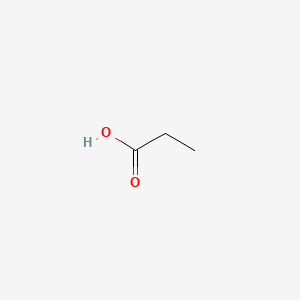propionic acid
propionic acid is a lipid of Fatty Acyls (FA) class. Propionic acid is associated with abnormalities such as Epilepsy, Infection, Tuberculosis, Alkalosis and Ischemia. The involved functions are known as Uptake, Biosynthetic Pathways, Methylation, Protein Overexpression and Biochemical Pathway. Propionic acid often locates in Body tissue, Cytoplasmic matrix, Membrane, Protoplasm and Extracellular. The associated genes with propionic acid are TRIO gene, TRRAP gene, SLC5A8 gene, SLC33A1 gene and Homologous Gene. The related lipids are Fatty Acids, Propionate, butyrate, Valerates and mycocerosic acid.
References related to genes published in Others
| PMID | Journal | Published Date | Author | Title |
|---|---|---|---|---|
| 9649600 | J. Nutr. | 1998 | Morita T et al. | Resistant proteins alter cecal short-chain fatty acid profiles in rats fed high amylose cornstarch. |
| 10484494 | Am. J. Physiol. | 1999 | Harada E et al. | Potentiation of carbachol-induced amylase release by propionate in guinea pig and vole pancreatic acini. |
| 11179416 | Mol. Biol. Cell | 2001 | Epstein CB et al. | Genome-wide responses to mitochondrial dysfunction. |
| 11514314 | Am. J. Physiol. Heart Circ. Physiol. | 2001 | Carvalho RA et al. | TCA cycle kinetics in the rat heart by analysis of (13)C isotopomers using indirect (1)H. |
| 11479277 | Glycobiology | 2001 | Zanetta JP et al. | Diversity of sialic acids revealed using gas chromatography/mass spectrometry of heptafluorobutyrate derivatives. |
| 12421838 | J. Nutr. | 2002 | Rodríguez-Cabezas ME et al. | Dietary fiber down-regulates colonic tumor necrosis factor alpha and nitric oxide production in trinitrobenzenesulfonic acid-induced colitic rats. |
| 12677015 | Stroke | 2003 | Santa N et al. | ATP-sensitive potassium channels mediate dilatation of basilar artery in response to intracellular acidification in vivo. |
| 12711718 | J. Neurophysiol. | 2003 | Johnson BN et al. | Rapid olfactory processing implicates subcortical control of an olfactomotor system. |
| 12892112 | Int. J. Syst. Evol. Microbiol. | 2003 | Wallace RJ et al. | Eubacterium pyruvativorans sp. nov., a novel non-saccharolytic anaerobe from the rumen that ferments pyruvate and amino acids, forms caproate and utilizes acetate and propionate. |
| 12867486 | Drug Metab. Dispos. | 2003 | Sprague CL and Elfarra AA | Detection of carboxylic acids and inhibition of hippuric acid formation in rats treated with 3-butene-1,2-diol, a major metabolite of 1,3-butadiene. |
| 10644316 | Gut | 2000 | Barcelo A et al. | Mucin secretion is modulated by luminal factors in the isolated vascularly perfused rat colon. |
| 10564143 | Am. J. Physiol. | 1999 | Leffler CW et al. | cAMP production by piglet cerebral vascular smooth muscle cells: pH(o), pH(i), and permissive action of PGI(2). |
| 10794671 | Am. J. Physiol., Cell Physiol. | 2000 | Maouyo D et al. | pH heterogeneity at intracellular and extracellular plasma membrane sites in HT29-C1 cell monolayers. |
| 10749735 | Am. J. Physiol. Heart Circ. Physiol. | 2000 | Spitzer KW et al. | Generation of intracellular pH gradients in single cardiac myocytes with a microperfusion system. |
| 9756546 | Am. J. Physiol. | 1998 | Ritucci NA et al. | Intracellular pH regulation in neurons from chemosensitive and nonchemosensitive areas of the medulla. |
| 9596720 | Infect. Immun. | 1998 | Kurita-Ochiai T et al. | Volatile fatty acid, metabolic by-product of periodontopathic bacteria, induces apoptosis in WEHI 231 and RAJI B lymphoma cells and splenic B cells. |
| 14722361 | Proc. Natl. Acad. Sci. U.S.A. | 2004 | Xiong Y et al. | Short-chain fatty acids stimulate leptin production in adipocytes through the G protein-coupled receptor GPR41. |
| 19264953 | Am. J. Physiol. Gastrointest. Liver Physiol. | 2009 | Aschenbach JR et al. | Bicarbonate-dependent and bicarbonate-independent mechanisms contribute to nondiffusive uptake of acetate in the ruminal epithelium of sheep. |
| 19553547 | J. Immunol. | 2009 | Andresen L et al. | Propionic acid secreted from propionibacteria induces NKG2D ligand expression on human-activated T lymphocytes and cancer cells. |
| 17360366 | Proc. Natl. Acad. Sci. U.S.A. | 2007 | Jain M et al. | Lipidomics reveals control of Mycobacterium tuberculosis virulence lipids via metabolic coupling. |
| 14985418 | J. Pharmacol. Exp. Ther. | 2004 | Christensen JK et al. | In vitro characterization of 5-carboxyl-2,4-di-benzamidobenzoic acid (NS3763), a noncompetitive antagonist of GLUK5 receptors. |
| 16772459 | J. Nutr. | 2006 | Bradford BJ et al. | Propionate challenge tests have limited value for investigating bovine metabolism. |
| 23401498 | Proc. Natl. Acad. Sci. U.S.A. | 2013 | Pluznick JL et al. | Olfactory receptor responding to gut microbiota-derived signals plays a role in renin secretion and blood pressure regulation. |
| 23814018 | Blood | 2013 | Tung S et al. | PPARα and fatty acid oxidation mediate glucocorticoid resistance in chronic lymphocytic leukemia. |
